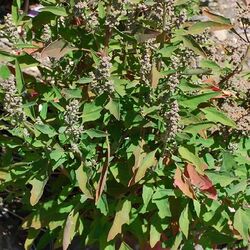Biology:Chenopodium nuttalliae
| Chenopodium nuttalliae | |
|---|---|

| |
| Scientific classification | |
| Kingdom: | Plantae |
| Clade: | Tracheophytes |
| Clade: | Angiosperms |
| Clade: | Eudicots |
| Order: | Caryophyllales |
| Family: | Amaranthaceae |
| Genus: | Chenopodium |
| Species: | C. nuttalliae
|
| Binomial name | |
| Chenopodium nuttalliae Saff.
| |
| Synonyms | |
|
Chenopodium berlandieri subsp. nuttalliae | |
Chenopodium nuttalliae is a species of edible plant native to Mexico. It is known by the common names huauzontle (literally "hairy amaranth", from the Nahuatl huauhtli 'amaranth' and tzontli 'hair') and Aztec broccoli. Other variations of the name include huauhzontle, huazontle, huanzontle, and guausoncle. It is related to other commonly-consumed plants such as quinoa, amaranth, and epazote, as well as the common American weeds goosefoot and lambsquarters. The plant grows upright branches with red tinted green leafy stems. Huauzontle stems superficially resemble baby broccoli, although the stems are much thinner, and support fewer of the leaves.
Like amaranth, huauzontle is very resistant to cold and dry climates, and grows even in poor soil. In addition, it has a high nutritional level, which makes it an excellent grain alternative in regions with difficulties sowing other types of cereals.[1]
During the rule of Moctezuma, huauzontle and amaranth were the fourth most important crops, after maize, beans, and chia. Many towns paid tribute to the Aztec empire in huauzontle.[2][3]
Culinary use
As with other members of the goosefoot family, the leaves, branches, flowers (inflorescence), and seeds of huauzontle are all edible. The plant is used both as a herb and as a vegetable in Mexican cuisine. While it is eaten throughout Mexico, it is most commonly consumed in the center of the country, especially in the states of Tlaxcala, Mexico, Guerrero, Morelos, and in the south of Mexico City.
The most popular dish is huauzontle pancakes stuffed with cheese and topped with tomato sauce. Alternatively, huauzontles can be encased in an egg batter and deep-fried with a stick of salty Mexican cheese. Huauzontle is used to season salads, ahuautles in pasilla sauce, and beef fillets. The mature seeds can also be ground into flour to make tortillas.
Like quinoa, another plant in the genus Chenopodium, huauzontle contains saponins, albeit in lesser quantities. While saponins are toxic to humans, huauzontle contains such small amounts that they pose no risk. Additionally, saponins are difficult for the human body to absorb, and are mostly rendered inactive when cooked.
References
- ↑ "Chenopodium berlandieri - ficha informativa". http://www.conabio.gob.mx/malezasdemexico/chenopodiaceae/chenopodium-berlandieri/fichas/ficha.htm.
- ↑ Redwood City Seed Company Catalog of Ecoseeds 2014.
- ↑ Charles B. Heiser Jr. and David C. Nelson (1 September 1974). "On the origin of the cultivated chenopods (Chenopodium)" (abstract page). Genetics 78 (1): 503–5. doi:10.1093/genetics/78.1.503. PMID 4442716. PMC 1213209. http://www.genetics.org/cgi/content/abstract/78/1/503.
External links
- Del polifacético, políglota y multicultural huauzontle. Navegaciones de Pedro Miguel
- Verde, el color de temporada
Wikidata ☰ Q5926347 entry
 |

